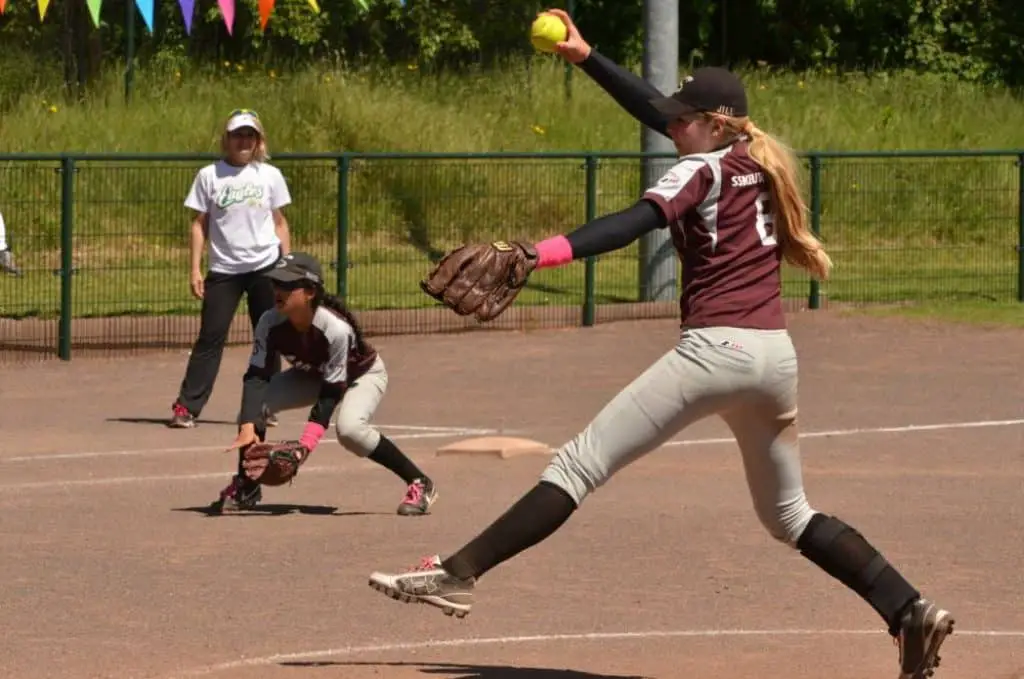Why Do Softball Pitchers Slap Their Leg? (Solved!)
Softball, as well as baseball, holds a rather special place in the world of sport.
The way of scoring, the shape of the field, no clock, and many other unique rules all make softball vastly different from any other major sport.
Plus, there are plenty of other small, peculiar details going on during the game that may seem weird and often confusing to those not too familiar with the sport.
One of those details that may seem strange is certainly the way pitchers slap their legs while delivering the pitch.
It’s something you’ve probably noticed even if you’ve watched only one softball game.
Even those who follow softball more closely are often unsure why do softball pitchers slap their leg.
Below, I’ll take a closer look at the reasoning behind this and explore what benefits (if any) it brings to the pitcher when releasing the ball.
So, let’s dive in!
Table of Contents
Why Do Softball Pitchers Slap Their Leg?
Here’s the list of various reasons softball pitchers use leg slaps and how it adds to their game.
Balance
For any pitch to be successful, the pitcher needs to be able to properly keep their balance.
As the pitching technique in softball is different than in baseball, the large wind-up motion can easily throw the pitcher off balance.
Therefore, while the throwing arm goes outside the body in a throwing motion, it’s necessary to transfer the weight from the back to the front foot.
Putting the glove hand down by the leg is an efficient way to provide the proper body balance.
Slapping that hand against the leg helps the pitcher develop this routine until it becomes a natural movement while pitching.
If the glove hand stayed outside the body, it would mess up the balance and the pitcher wouldn’t be able to transfer the same force to the throwing hand and efficiently throw the ball.
Timing
Besides proper balance, another essential component of a successful pitch is perfect timing of wrist snap and throwing the ball.
Pitchers use different techniques to help them with timing, but a leg slap is probably the most efficient.
This is especially useful at a young age when pitchers are still trying to get a sense of proper timing. A slap on the leg serves as a useful signal for the moment when the wrist snap needs to happen.
If you watch the accomplished pitchers, you’ll notice that as the throwing hand begins the upward movement from the hip, their glove hand moves downward, so it can slap the leg at the perfect moment for release.
Distraction
Slapping the leg with the glove hand during the pitching motion is sometimes used as a way to distract the opposing batter.
This is especially the case in games at younger age groups as less experienced players are more easily distracted.
As the batter is expecting the pitch, a slap on the leg can draw their attention from where it’s supposed to be and cause them to take their eye off the pitch itself.
Additionally, the sound of the slap can mess up their concentration.
Of course, this is only the case, if the fans and other sounds on the field are not too loud, so the batter can hear the slap in the first place.
Still, as players grow and develop and move on to higher levels of the game, this distraction technique is not as effective.
More experienced batters know better than to be distracted by the slap.
Communication
Proper communication between the pitcher and the catcher is the foundation for good defensive play.
This is where the leg slap can come in handy, as it can serve pitchers to improve the way they communicate with the catchers and send them signals when pitching.
Notably, the slap on the leg is used for these purposes mostly at a higher level of the game and among the more experienced players.
In case the opposing team steals or is aware of signals in any other way, the pitcher and the catcher can use a leg slap as an alternative way to communicate with each other and still stay on the same page.
A glove slap can mean whatever pitcher and catcher agree to but is commonly used to signal a change of pitches or throw to the base.
Are There Any Downsides to the Leg Slap?

As described above, there are some perfectly reasonable explanations for why pitchers slap their glove hand against their legs while pitching and why is it good for them.
However, sometimes leg slaps can be beneficial for the opposing hitter.
Experienced and expert hitters can use leg slap to get a sense of the timing of the release of the pitch.
This comes in particularly when facing fast pitchers and having a hard time hitting off them.
Hearing the glove slap against the leg signals them to get ready for the swing and load up the back foot for the power hit.
Still, this takes a lot of skill on the side of the batter as it’s only useful if you properly assess the timing of the pitch.
Scouting the pitcher can be of help here as it can provide information on how much time passes between the leg slap and pitch delivery.
Conclusion
Slapping the glove hand against the leg is pretty common in softball, even though some coaches are against it and advise their players against it.
Still, it can be very useful for some pitchers as it helps them balance their body, time the pitch to perfection, communicate with the catcher, and sometimes even distract the opposing player.
Some pitchers will use leg slaps for all these purposes, and some will find them useful for just some of them.
So, a leg slap can often be an important component of a successful pitch, but it’s not a necessary one.
The best thing to do is to listen to the coach and trust their judgment as to whether the leg slap is appropriate for a certain pitching style and whether can it contribute to becoming a better pitcher.




